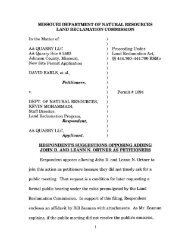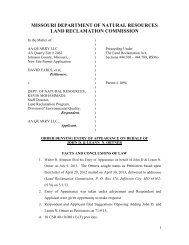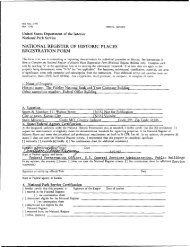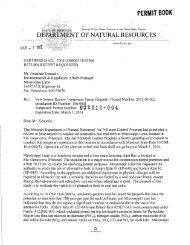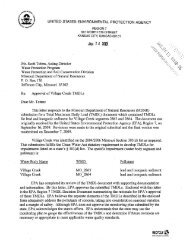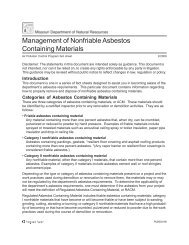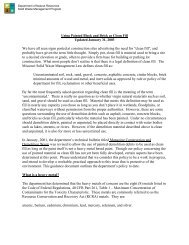Winter 2006 - Missouri Department of Natural Resources
Winter 2006 - Missouri Department of Natural Resources
Winter 2006 - Missouri Department of Natural Resources
You also want an ePaper? Increase the reach of your titles
YUMPU automatically turns print PDFs into web optimized ePapers that Google loves.
Jane Bishop<br />
Environmental Protector<br />
In support <strong>of</strong> environmental causes<br />
for more than 30 years, Jane<br />
Bishop, <strong>of</strong> St. Charles, was honored in<br />
June 2005 as an Environmental Pioneer<br />
by the St. Charles Social Justice<br />
Alliance. The Alliance, headquartered<br />
in Wentzville, works to educate the<br />
public about social justice issues, including<br />
related concerns such as environmental<br />
protection. Bishop helped<br />
establish St. Charles’ Enthusiasts for a<br />
<strong>Natural</strong> Environment (SCENE), which<br />
started its own recycling program in<br />
the early 1970s and then helped establish<br />
the St. Charles Recycling Cen- Jane Bishop<br />
ter in 1976. Bishop served as the center’s<br />
director from 1976 to 1990. “The recycling center was the first<br />
in the county,” she told Jason Lee <strong>of</strong> the Suburban Journals <strong>of</strong><br />
Greater St. Louis. “We began to realize that our resources are finite<br />
and our landfills were going to be overfilled, which causes water<br />
and air pollution.”<br />
Bishop also has served as president <strong>of</strong> the <strong>Missouri</strong> Waste Control<br />
Coalition, a member <strong>of</strong> the St. Charles County Solid Waste Committee,<br />
an advisor and volunteer for Recycle Roundup and is currently<br />
a member <strong>of</strong> the St. Charles County Environmental Quality<br />
Commission. For the past 10 years, Bishop served as chairwoman<br />
<strong>of</strong> the Environmental Roundtable Task Force <strong>of</strong> Healthy Communities<br />
in St. Charles County. Her community work includes membership<br />
in the St. Charles League <strong>of</strong> Women Voters and time volunteering<br />
for Youth in Need when the organization started in the<br />
mid-1970s.<br />
Bishop <strong>of</strong>ten works as a link between the task force and the St.<br />
Charles community. She says that the most effective way to educate<br />
the public about environmental concerns is to generate lasting<br />
partnerships between businesses, local agencies and nonpr<strong>of</strong>it<br />
groups. “The longer I’ve been involved in environmental<br />
issues, the more I’ve realized how interconnected the environment<br />
is with everything else,” Bishop said. “And with four children and<br />
now two grandchildren, I’ve always been concerned about what<br />
kind <strong>of</strong> world we are leaving.” She recently became involved with<br />
Greenway Network, a grassroots, volunteer-based organization<br />
working to conserve natural resources, protect area watersheds<br />
and preserve the quality <strong>of</strong> life for the community.<br />
Bishop believes that there are many more opportunities for education<br />
in schools today, but schools don’t reach families and the<br />
community like they once did. She encourages people to work together<br />
on raising awareness about local, state and national issues.<br />
She and husband Gordon have been married 54 years. They have<br />
lived in St. Charles 52 <strong>of</strong> those years. They have four children,<br />
Mark, Steve, Nancy and Timothy, and two grandchildren. “I’ve had<br />
some health problems recently,” Bishop admits, “but I keep pushing<br />
recycling and doing what I can,” she said, “We need to continually<br />
push the idea <strong>of</strong> zero waste. The goal is to get as much <strong>of</strong> it<br />
reused and recycled as possible.”<br />
Mrs. Bishop recently celebrated her 80th birthday, but continues to<br />
use her phone and community contacts to stay involved. We are<br />
pleased she will be taking a seat at the head <strong>of</strong> the class, in Resource<br />
Honor Roll.<br />
Holly Neill<br />
Water Values<br />
As a child, Holly Neill didn’t like<br />
swimming in water so murky that<br />
she couldn’t see her feet when she<br />
stepped in. Now, as executive director<br />
<strong>of</strong> the nonpr<strong>of</strong>it James River Basin Partnership<br />
(JRBP) in Springfield, she has<br />
made a career <strong>of</strong> protecting and increasing<br />
clean water resources. “Algaechoked<br />
and sediment-filled water just<br />
won’t do,” said Neill, “and I will work<br />
my darnedest to make sure my favorite<br />
places here in the Ozarks still let me<br />
see my feet when I jump in.” Since December<br />
2003, she has conducted<br />
grant-funded environmental studies,<br />
Holly Neill<br />
supervised community and volunteer<br />
events, administered educational outreach projects and implemented<br />
programs that further the partnership’s mission to protect and<br />
improve water quality in the Ozarks. Her excitement about the job<br />
has encouraged participation in James River projects, according to<br />
Martin Mac Donald, chairman <strong>of</strong> the JRBP board <strong>of</strong> directors.<br />
“If you truly love and respect something, protecting it should be<br />
easy. Convincing others <strong>of</strong> its importance; that can be challenging,”<br />
said Neill. She spent her childhood in West Plains, but was only 25<br />
minutes from the North Fork <strong>of</strong> the White River and 45 minutes from<br />
Norfork Lake in Arkansas. There, her family enjoyed swimming and<br />
spending time on their pontoon boat. “Every weekend, sometimes<br />
during the week, I was at the river or the lake,” said Neill, now a<br />
long-distance swimmer. “Everything in my life revolves around<br />
water.” The partnership <strong>of</strong>fers financial incentives for septic tank<br />
owners to get their tanks pumped out, helping pay for more than<br />
300 since February, 2005. It is estimated that more than 70 percent<br />
<strong>of</strong> <strong>Missouri</strong>’s septic tanks do not function properly. This threatens<br />
the state’s water resources with 100 million gallons <strong>of</strong> poorly treated<br />
sewage per day. According to Neill, most <strong>of</strong> the people don’t<br />
know they are required to maintain them.<br />
Neill graduated from Southwest <strong>Missouri</strong> State University (SMSU)<br />
with a Bachelor <strong>of</strong> Science in Biology and a Masters <strong>of</strong> <strong>Natural</strong> and<br />
Applied Science. Her thesis research was done at the Ozark underground<br />
laboratory in Taney County on “The Effects <strong>of</strong> Land Use on<br />
Tumbling Creek Cave.” Neill served with the Peace Corps in Jamaica<br />
at the Discovery Bay Marine Lab and was part <strong>of</strong> a National Science<br />
Foundation Fellowship Program at SMSU involving scientists in the<br />
local public school system. She now lives near the James River and<br />
has taken part in water quality improvement efforts for several years.<br />
“We are all connected to water in some way,” Neill said. “By enjoying<br />
it as a recreational benefit, for drinking water for us or our livestock,<br />
or using it to clean little children that can always find the dirt<br />
and mud, water is something we all value whether we realize it or<br />
not.” Neill credits the local media for helping to raise community<br />
awareness about the septic tank program. She praises the “corporate<br />
garage sale” put on each year by Bass Pro Shops <strong>of</strong> Springfield<br />
as a fundraising effort in support <strong>of</strong> the JRBP’s annual river cleanup.<br />
“The successes and accomplishments <strong>of</strong> the JRBP are not the work<br />
<strong>of</strong> any one person,” she said. “It is truly a team effort. I truly feel honored<br />
to work side-by-side with our partners on our common goal: to<br />
protect and improve our wonderful water resources.”<br />
The next time we can see our feet in an Ozark stream, we should<br />
thank Holly Neill.<br />
<strong>Winter</strong> <strong>2006</strong> 19



